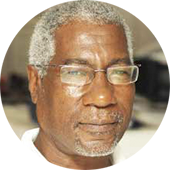
I HEARD quite a lot of senseless talk during before and during the visit here by the US Navy’s hospital ship, USNS Comfort. Conspiracy theorists went back 87 years to the Tuskegee experiment and 60 years aback to its Guatemala equivalent, both involving germ warfare against Blacks in the USA and Hispanics in South America, respectively.
In both cases, innocent human beings were used as guinea pigs to experiment on to trace the effects of drugs on their reproductive capacities. But Tuskegee and Guatemala revealed what always exists: dark deeds buried in the deepest recesses of the minds of humans wanting to use science to control the shape of the human race. Adolf Hitler tried it in Nazi Germany, Cecil Rhodes perfected it in Apartheid Rhodesia and it became branded in racist South Africa.
Countless such experiments have been uncovered over time. AIDS, Ebola and other previously unknown diseases have been either discovered or invented — and even patented. But while experiments involving germ warfare and genetic experimentation will not have disappeared, they’d have to be undertaken today with extreme care to avoid early discovery.
Using science to alter humanity isn’t just an idea. Humans already create humans and animals artificially; and Artificial Intelligence can lead to creation of robots that’ll outsmart humans. But what else do we know about who’s doing what and where today, to find the ways and means to dominate the human race?
What’s all this got to do with the American hospital ship? Nothing actually. But there was much talk about it having been deployed to the Caribbean as part of a grand plan to help America depopulate Black people worldwide.
Pundits and pandits outdid each other to discourage Saint Lucians (and other Caribbean people) from taking-up the rare offer of free medical care, in the process spewing everything from reverse racism to mere ignorance bred by fears permanently anchored in the deepest recesses of their memory bank.
All who wanted to know what the ship does could have found out that it is attached to the US Armed Forces Southern Command and its current mission is not only aimed at the couple thousand persons expected from each Caribbean islands, but more specifically at the ‘three millions Venezuelans’ the US claims are seeking greener pastures in neighboring Caribbean and Latin American states.
Staffed with 320 medical professionals from the United States, Canada, Mexico, Argentina, Brazil, Costa Rica and Peru, the hospital ship’s current deployment includes stops in Colombia, Costa Rica, Dominican Republic, Ecuador, Grenada, Haiti, Jamaica, Panama, Saint Lucia, St Kitts and Nevis and Trinidad and Tobago.
It’s a non-combatant hospital vessel typically staffed by officers of the Navy’s Medical Corps, Dental Corps, Medical Service Corps, Nurse Corps and Chaplain Corps, and enlisted Hospital Corpsman personnel.
It’s primarily visiting areas hosting Venezuelan refugees – and most of the countries it will call at support of the US position on Venezuela at the Organization of American States (OAS).
Before the hospital ship arrived here it had treated 6,000 persons in Trinidad & Tobago, with 115 surgeries recorded. In Grenada, it attended to 5,156 people, including 96 surgeries. But on one trip to Peru in July, it attended to some 4,500 Venezuelans, with over 100 surgeries.
Figures are not yet available for Saint Lucia, but (from all indications) they won’t be small.
I went to both processing sites, but never got even near the heavily guarded gates. There were many complaints from persons who didn’t get treated for any number of reasons. On the other hand, just as many seemed lucky enough to have been attended to at least three times.
Initial reports that Saint Lucia was the ‘most orderly’ of countries visited soon vaporized as people realized just how easy it all was. Some Saint Lucians also took to the media to foolishly criticize fellow citizens for ‘liking too much freeness’.
But be all that as it may, I have absolutely no regrets having encouraged Saint Lucians needing healthcare to take full advantage of the hospital ship’s visit.
As far as I’m concerned, if one life was saved and one amputation was avoided, or one person’s sight was saved, it will have been worth it all.
When the American ship leaves, those cared for free will be on their own, once again, to face a national healthcare system that everyone agrees is in shatters but no one seems able to surgically repair with the urgency demanded.
Those who could not afford healthcare here before the ship came will still be unable to pay, the dates for commissioning of the new national hospital will continue to shift closer to the next General Elections, the future of St Jude’s will remain very distant and the search for a national health insurance scheme will continue to look like searching for a rusty injection needle at the Deglos landfill.
But the thousands here who got free medical care will be glad they defied the naysayers and domestic prophets of doom and gloom, while those who wanted to but didn’t will regret, or just wish they’d followed their healthy minds.
Now that the Americans have come and gone, perhaps many more here will also realize that the Cuban medical mission, from a country where people have a right to free medical care, is still here after 40 years.
When the USNS Comfort’s Saint Lucia figures are finally released, the numbers will still not compare with the tens of thousands of Saint Lucians who’ve also directly benefitted from free Cuban healthcare — here and in Cuba in the past four decades.
But, just like with crime, it’s unhealthy to treat human beings seeking better healthcare as mere statistics to be compared to score political points, or to justify unhealthy actions.
What matters most is that people who needed but couldn’t get quality healthcare here got it – and for free!












